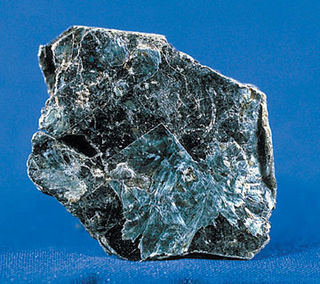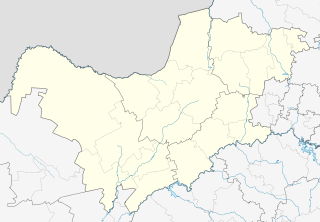Related Research Articles

Libby is a city in northwestern Montana and the county seat of Lincoln County. The population was 2,628 at the 2010 census.

Vermiculite is a hydrous phyllosilicate mineral which undergoes significant expansion when heated. Exfoliation occurs when the mineral is heated sufficiently, and commercial furnaces can routinely produce this effect. Vermiculite forms by the weathering or hydrothermal alteration of biotite or phlogopite. Large commercial vermiculite mines currently exist in Russia, South Africa, China, and Brazil.

Mesothelioma is a type of cancer that develops from the thin layer of tissue that covers many of the internal organs. The most common area affected is the lining of the lungs and chest wall. Less commonly the lining of the abdomen and rarely the sac surrounding the heart, or the sac surrounding the testis may be affected. Signs and symptoms of mesothelioma may include shortness of breath due to fluid around the lung, a swollen abdomen, chest wall pain, cough, feeling tired, and weight loss. These symptoms typically come on slowly.

The Agency for Toxic Substances and Disease Registry (ATSDR) is a federal public health agency within the United States Department of Health and Human Services. The agency focuses on minimizing human health risks associated with exposure to hazardous substances. It works closely with other federal, state, and local agencies; tribal governments; local communities; and healthcare providers. Its mission is to "Serve the public through responsive public health actions to promote healthy and safe environments and prevent harmful exposures." ATSDR was created as an advisory, nonregulatory agency by the Superfund legislation and was formally organized in 1985.

Pneumoconiosis is the general term for a class of interstitial lung diseases where inhalation of dust has caused interstitial fibrosis. Pneumoconiosis often causes restrictive impairment, although diagnosable pneumoconiosis can occur without measurable impairment of lung function. Depending on extent and severity, it may cause death within months or years, or it may never produce symptoms. It is usually an occupational lung disease, typically from years of dust exposure during work in mining; textile milling; shipbuilding, ship repairing, and/or shipbreaking; sandblasting; industrial tasks; rock drilling ; or agriculture.
Dust to Dust may refer to:

Tremolite is a member of the amphibole group of silicate minerals with composition: Ca2(Mg5.0-4.5Fe2+0.0-0.5)Si8O22(OH)2. Tremolite forms by metamorphism of sediments rich in dolomite and quartz. Tremolite forms a series with actinolite and ferro-actinolite. Pure magnesium tremolite is creamy white, but the color grades to dark green with increasing iron content. It has a hardness on Mohs scale of 5 to 6. Nephrite, one of the two minerals of the gemstone jade, is a green variety of tremolite.
The mineral asbestos is subject to a wide range of laws and regulations that relate to its production and use, including mining, manufacturing, use and disposal. Injuries attributed to asbestos have resulted in both workers' compensation claims and injury litigation. Health problems attributed to asbestos include asbestosis, mesothelioma, cancer, and diffuse pleural thickening.

W. R. Grace and Company is an American chemical business based in Columbia, Maryland. It produces specialty chemicals and specialty materials in two divisions: Grace Catalysts Technologies and Grace Materials and Chemicals. For much of its early history, Grace's main business was in South America, in maritime shipping, railroads, agriculture, and silver mining, with 30,000 employees in Peru. In the 1950s, Grace began to diversify and grew into a Fortune 100 worldwide conglomerate. After emerging from a prolonged bankruptcy period of 12 years in 2014, the company spun off its other major operating divisions, marking the end of the global Grace empire. As of December, 2017, it had 3,700 employees, with 1,900 in the United States and the balance in Europe and Asia. In 2017, the annual sales were US $ 1.72 billion.
Montana State Highway 37 is a 67.048-mile-long (107.903 km) state highway in the US state of Montana. It begins in downtown Libby, Montana at US 2 and takes a meandering course northeastwards upstream along the Kootenai River and the eastern shore of Lake Koocanusa before terminating at U.S. Route 93 at the northern end of Eureka, Montana. Previously, MT 37 also followed US 93 from Eureka into Whitefish and turned down what is now MT 40 towards US 2 and Glacier National Park until at least 1942.

Pomfret is a desert town, the site of an old asbestos mine, on the edge of the Kalahari desert in northwest South Africa. It is the administrative centre of Molopo Local Municipality. Many of its inhabitants are former members of 32 Battalion, also known as Buffalo Battalion. These ex-soldiers were predominantly Portuguese-speaking Angolans who fought on the South African government side in Angola and Namibia, and after the end of the South African Border War to police the black townships. The community remains largely Portuguese-speaking.
William "Bill" Campbell is a former Time Magazine photojournalist and a current documentary filmmaker and the president of Homefire Productions, Inc. He is married to Maryanne Vollers.

The 2000 United States Senate election in Montana was held November 7, 2000. Incumbent Republican U.S. Senator Conrad Burns won re-election to a third term. As of 2020, this is the last time the Republicans have won the Class 1 Senate Seat from Montana as well as the last time Montana voted for the same party for president and senate simultaneously.

Asbestos is a term used to refer to six naturally occurring silicate minerals. All are composed of long and thin fibrous crystals, each fibre being composed of many microscopic 'fibrils' that can be released into the atmosphere by abrasion and other processes. Asbestos is an excellent electrical insulator and is highly heat-resistant, so for many years it was used as a building material. However, it is now a well-known health and safety hazard and the use of asbestos as a building material is illegal in many countries. Inhalation of asbestos fibres can lead to various serious lung conditions, including asbestosis and cancer.

Butte, America is a 2008 documentary film about Butte, Montana's history as a copper mining town. It was created by Pamela Roberts, narrated by Gabriel Byrne, and includes a mix of first hand accounts and scholarly analysis from John T. Shea, Marie Cassidy, David Emmons, and Janet Finn. The movie focuses on developments in American labor and production during the dawn of the electrical age in the 1880s when copper was discovered in Butte. The mining activity brought an influx of immigrant workers and their families to the boom town that grew to be a Western metropolis of 45,000 people forming a Rocky Mountain city that with similarities to Pittsburgh in the East. Labor relations and the corporate operations of Anaconda Copper are also related.
Alice – A Fight For Life is a documentary featuring 47-year-old Alice Jefferson, a British woman who developed malignant pleural mesothelioma thirty years after working for nine months at Cape Insulation's Acre Mill asbestos plant in Hebden Bridge, West Yorkshire. The film also explored the health issues surrounding the manufacture and use of asbestos products. Described by The Guardian newspaper as "a momentous film", the programme also explicitly linked asbestos with cancer, and attacked what it perceived as the government's complacency in limiting the manufacture and use of asbestos in Britain.
Stephen M. Levin was the medical director of the Mount Sinai Irving J. Selikoff Center for Occupational and Environmental Medicine, a professor of occupational medicine at the Mount Sinai School of Medicine, and the co-director of the World Trade Center Worker and Volunteer Medical Screening Program. A graduate of Wesleyan University and then New York University School of Medicine, Levin was born and raised in Philadelphia to working-class parents—his father a carpenter, his mother a hospital worker. He was recognized worldwide as a leader in the field of occupational medicine, particularly due to his work on behalf of 9/11 workers and those injured by asbestos in the town of Libby, Montana.

Andrew Jay Schneider was an American journalist and investigative reporter who worked for the Pittsburgh Press and Seattle Post-Intelligencer as a public-health reporter. He received back-to-back Pulitzer Prizes while working for the Press: one in Specialized Reporting in 1986 with Mary Pat Flaherty, and another for Public Service with Matthew Brelis and the Press in 1987. Schneider also co-authored a book about an asbestos contamination incident in Libby, Montana, entitled "An Air That Kills".
Steve Gunderson is an American politician from Montana. Gunderson serves as a Republican member of the Montana House of Representatives from District 1, including Libby, Montana.

The 2018 wildfire season in Montana began around June, 2018.